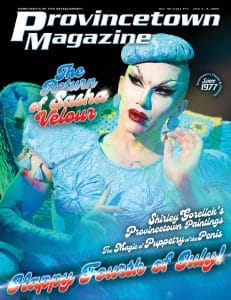by Rebecca M. Alvin
Artists of all stripes have been subjected to the desires of their admirers to box them in, fix them in one artistic school or the other, force them to stay chained to one medium—or at most, two—and to conform to their expectations time and time again. Working within the shackles of unreasonable rules can even be a creative jump-start; the Surrealists made up games and processes specifically incorporating irrational rules in order to force themselves to expand their imaginations within the confines of restriction.

Chicago-based artist Zehra Khan takes a different approach to the external expectations placed upon her. She simply disobeys.
Her first solo exhibition at the Provincetown Art Association and Museum (PAAM), which is curated by Megan Hinton, features works marked by a woman with a diverse background, drawn to materials and methods as different as collaged tapestry, painted bedsheets, and bodypainting. But when Khan first came to Provincetown as a graduate student in the low-residency MFA program of Massachusetts College of Art, which used to be housed in the Fine Arts Work Center here, (the program has since been discontinued), she came as a painter and two-dimensional artist. “I was shocked when people called me a sculptor. Because I started out thinking I was, you know, a painter. And then it just seemed like my interests quickly evolved into multimedia,” she recalls.
The PAAM show, Your Everyday Myths, runs through August 28 and features work in various media, including sculptures made with hot-glue gun glue, carved, and then painted, as well as fabric paintings, video installations, and short films. Khan gave the show its title “because I work in so many mediums I tried to think what was maybe the more encompassing thing. In my work, and emotionally, I feel like I’m talking about mythology, like everyday situations turned grandiose or mythic or surreal, twisted, kind of like twisted fairy tales.”

(acrylic painting on CD,5×5”)
But something that may appear more obvious to the viewer is the multitude of references and iconography in her work. This is, perhaps, due to another aspect of Khan’s background. She was born in Indonesia, grew up in Europe mostly, and her parents are from Idaho and Pakistan. Completely comfortable in her multicultural identity, Khan is unfazed when faced with other people’s desires to put her in a cultural box that they can better understand. Case in point: While being interviewed for this story at PAAM, an admirer asked if she was Zehra Khan. She said she was. He then asked where she was from, to which Khan replied, “All over the place, but I lived in Ptown for 10 years and now I’m in Chicago.” Not contented with the answer, he asked, “So is ‘Khan’ Pakistani?” She said yes, to which he replied, fully satisfied, “So you’re Pakistani.”
“Wasn’t that so interesting?” she reflects later, not offended, but genuinely curious. Here was a fan of her work effusive about its merits, but unable to grasp the complexity of Khan’s identity, something that seems foundational to it, in fact.

(acrylic paint on paper, masking tape,
Internet cable, and wire,8x10x5”)
“It was a perfect example of what happens… People don’t know where I’m from, which I think is perfectly fine. I barely know where I’m from,” she says with a laugh. “I talk to all kinds. Some want to say I’m Pakistani and some want to say I’m American, right? It’s fine. They’re all going to say whatever they want. Even my family! But they all love me, they all include me, though. There’s no problem. I’m just family—I’m just moron number four, you know, to them, but I think that’s why I’m so interested in travel and multicultural identity because I get to really define it a lot myself. I had to research my heritage. I went back to Pakistan because I’d never lived there. I don’t speak Urdu. All these kinds of quests for my identity were totally self-made. The notion of home is very flexible in my world.”
As you might expect, the range of her influences is also diverse. She cites Salvador Dalí and Vincent Van Gogh as early influences, but also connects to the fluxus movement, to the women quilters in her family, and to pointilism, which she says she uses without being “too faithful to the rules.” Intricate lace-like glue sculptures evoke her Pakistani roots, her films are playful, with ties to dada and surrealism, especially with their humorous tone, and the gallery at PAAM is filled with blankets and bedsheets, speaking to female endeavors as much as the universal desire for comfort, the pleasures of sleep, the promise of our dreams.
“My great, great grandma was a quilt maker. But I myself don’t have the type of patience, which is required for embroidery and the exacting nature of quilts. So my version is like, I always joke, I don’t have straight lines in any of my work because I don’t like it. I like everything to be more soft and organic. And especially in the hot-glue pieces that are hanging from the ceiling, those works kind of reference my Pakistani side or Indian textiles and Pakistani textiles and their geometric repetition,” she explains looking around at her work. “I’m very much into breaking up space into small marks or geometric patterns. So it’s kind of like the repetition creates an accumulation and a rhythm and propels the piece forward.”

Laundrette a.k.a. Bunny Laundry Day, 2018
(3 minute video by Khan and Ivy Guild)
The label is not so important. The works evoke feelings, ideas, larger concepts, and it isn’t relevant if they are works of a certain tradition or style. The mixing of materials, like the mixing of influences, ethnicities, and identities is in fact the ultimate statement made. At the same time, Khan’s playfulness, her grounded personality, and sense of humor come through in her explanation for why these particular materials were chosen.
(ink on bedsheet, 95 x 99”) and Golden Culprit, 2019
(acrylic paint on hot glue, 24 x23”)
“Personal association. This last series really involved bedsheets and blankets. It’s quilts, king-size bed sheets, and I like to leave the tags on, and sometimes paint on them myself, because it feels like being in bed is the most kind of domestic and intimate situation you can be in. And it kind of connotes dreaming and intimacy,” she explains of the large, hanging fabric pieces, which also are painted on the other side.
Then she adds, “And it’s convenient as heck! Can you imagine if I had a painting show [like this]? This all fit in my hatchback… I love being able to make work that also suits my lifestyle.”

Zehra Khan: Your Everyday Myths is on view at PAAM, 460 Commercial St., Provincetown, through August 28. There is a public talk with Khan and curator Megan Hinton on Thursday, August 4, 6 p.m. For more information call 508.487.1750 or visit paam.org.








